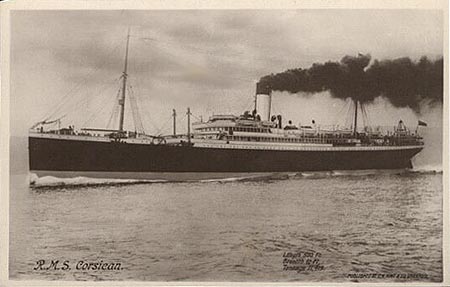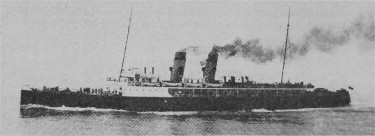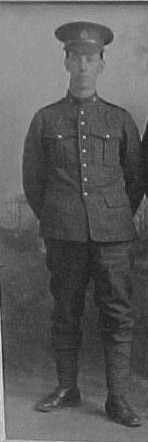| Fred Clark was the son of
William and Grace Clark of Hope Township. He was educated at the Public School, Port Hope,
and from an early age engaged in farming. He enlisted a day or two after his brother in
the 136th Battalion - 13 April 1916 - and both went through their military training
together in Canada and England.
They
were separated when they went to France - Charles going to the 87th and Fred to the 21st
Battalion, C.E.F. Fred was wounded 10 April 1916 at Vimy Ridge. He was removed to hospital
in England where he remained for about six moths convalescing.
He eventually returned to the front and
while engaged in carrying in a wounded comrade, he was shot and killed by a German sniper.
Neither the place of his death nor the location of his grave is known, he died 02 April
1918 during the time when the enemy was making such headway towards Paris and the Channel
Ports.
(Webmaster's Note: Pte Frederick Clark,
805531, is memorialized on the Vimy Memorial)

|
|
Photo and
text reproduced with permission
Taken from the "Book of Remembrance (A
record of the men of Port Hope who participated in the Great War of 1914-1918)" by
James A. Elliott, Chairman of Committee, Port Hope, Jan. 1st, 1919.
|
|
|
Jul 16, 1886
|
Born in Port
Hope, Ontario to William and Grace (nee Benton) Clark
|
|
Mar 13, 1916
|
Attested into
the 136th Battalion in Port Hope, Ontario
Ø Number 805531
Ø Next of kin given as Mrs. Grace Clark, mother, Port Hope, Ontario
Ø Previous occupation given as Labourer
Ø No previous military experience given
Ø Religion given as Methodist
|
|
Aug 12, 1916
|
Awarded 10 days
detention. The offence that prompted this
punishment is not recorded in the file.
|
|
Sep 25, 1916
|
Embarked the RMS
Corsican in Halifax, Nova Scotia

|
|
Oct 6, 1916
|
Disembarked in
Liverpool, England and the battalion proceeded to the West Sandling Camp, where it was
absorbed into the 39th Reserve Battalion for further training.
|
|
Jan 4, 1917
|
The 39th
Reserve Battalion was absorbed into the newly formed 6th Reserve Battalion at
West Sandling.
|
|
Feb 1, 1917
|
Transferred to
the 21st Battalion
|
|
Feb 2, 1917
|
Arrived at the
CBD (Canadian Base Depot) in the Rouelles Camp, Havre, France as part of a draft of 29
reinforcements for the front and TOS (Taken On Strength) the 21st Battalion.
|
|
Feb 21, 1917
|
Left the CBD to
join the 2nd Entrenching Battalion.
|
|
Feb 24, 1917
|
Joined the 2nd
Entrenching Battalion in Hersin as part of a draft of 68 reinforcements destined for the
21st Battalion.
|
|
Mar 3, 1917
|
Left the 2nd
Entrenching Battalion to join the 21st Battalion as part of a draft of 20
reinforcements.
|
|
Mar 6, 1917
|
Joined the 21st
Battalion in Divisional Reserve billets in Bois Des Alleux.
|
|
May 8, 1917
|
Admitted to the
No. 4 CFA (Canadian Field Ambulance) and transferred the same day to the No. 5 CFA
diagnosed with Myalgia in both legs.
|
|
May 12, 1917
|
Transferred to
the #13 Stationary Hospital in Boulogne.
|
|
May 21, 1917
|
Invalided to
England aboard the Hospital Ship Jan Breydel

Posted to the
EORD (Eastern Ontario Regimental Depot) while in hospital.
|
|
May 22, 1917
|
Admitted to the
Edinburgh War Hospital.
|
|
Jun 19, 1917
|
Transferred to
the Princess Patricia Canadian Red Cross Hospital in Ramsgate.
|
|
Jul 3, 1917
|
Discharged from
hospital and placed On Command to the 3rd CCD (Canadian Convalescent Depot) to
further recuperate and for rehabilitation at the St. Leonard’s Hospital.
|
|
Aug 30, 1917
|
Discharged from
the 3rd CCD and posted to the 6th Reserve Battalion, Seaford.
|
|
Dec 6, 1917
|
Posted to the 21st
Battalion.
|
|
Dec 7, 1917
|
Arrived at the
No. 2 CIBD (Canadian Infantry Base Depot), Etaples, France as part of a draft of
21reinforcements from England and TOS the 21st Battalion.
|
|
Dec 26, 1917
|
Left the CIBD
and joined the CC Rein C (Canadian Corps Reinforcement Camp) in Calonne Ricouart.
|
|
Feb 3, 1918
|
Admitted to the
No. 6 CFA with a diagnosis that reads PUO (Pyrexia of Unknown Origin) which is a fever
without a known cause. Very often this is
referred to as Trench Fever.
|
|
Feb 4, 1918
|
Transferred to
the No. 30 CCS (Casualty Clearing Station) for further treatment.
|
|
Feb 18, 1918
|
Discharged from
the #30 CCS to duty and rejoined the 21st Battalion in Brigade Support near
Mericourt, south of Lens.
|
|
Apr 2, 1918
|
During the night
of April 1-2, the battalion was relieved from the front line near Neuville Vitasse and
moved back a short distance into the support trench.
There is nothing in the service file or the battalion’s records to indicate
how Private Clark was killed, however the Book of Remembrance published in 2007 by the
Port Hope, Ontario Archives records that “while engaged in carrying in a wounded
comrade, he was shot and killed by a German Sniper.”
His body was
never recovered from the battlefield and is subsequently honoured on the Canadian National
Vimy Memorial, Vimy Ridge, France.

Following the
war the British War Medal, Victory Medal and Memorial Cross were sent to his mother, Mrs.
Grace Clark, RR #1 Port Hope, Ontario.
The Plaque
(Dead Man’s Penny) and Scroll were sent to his father, William Clark, at the same
address.
|
|




